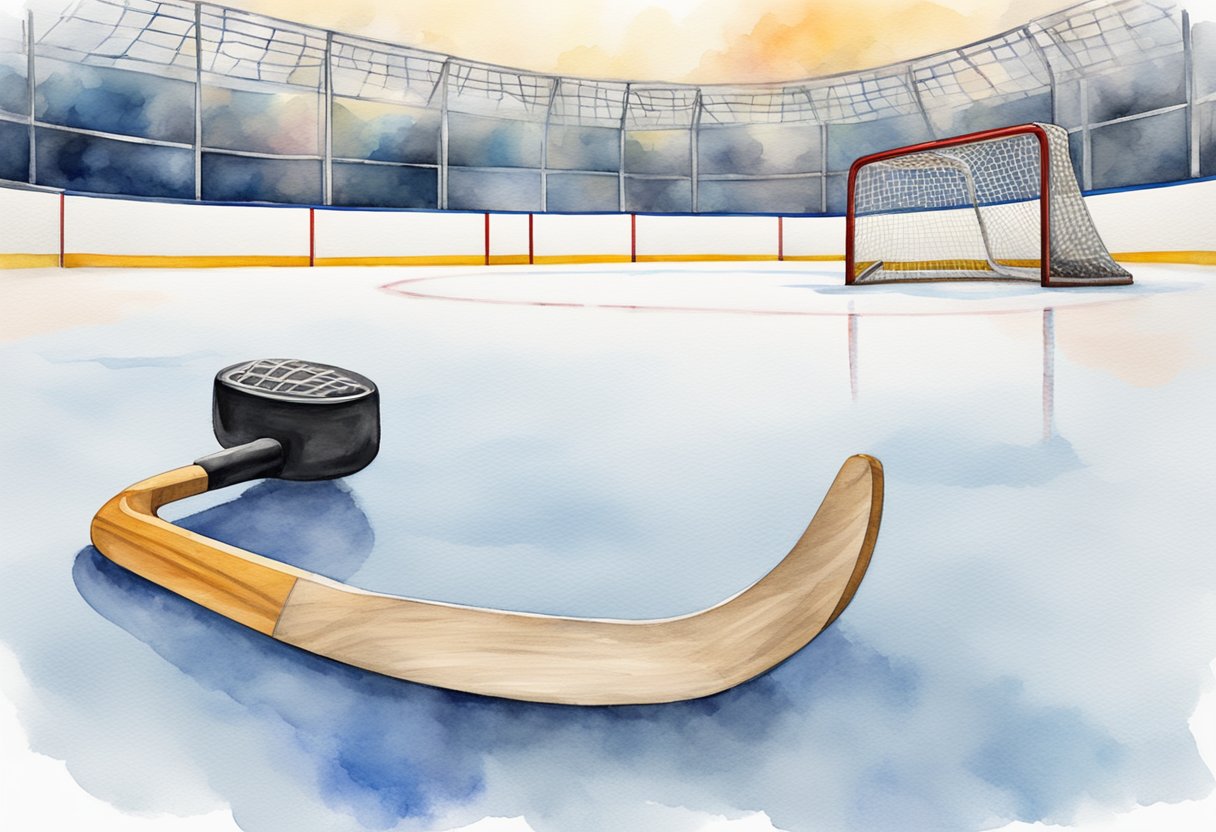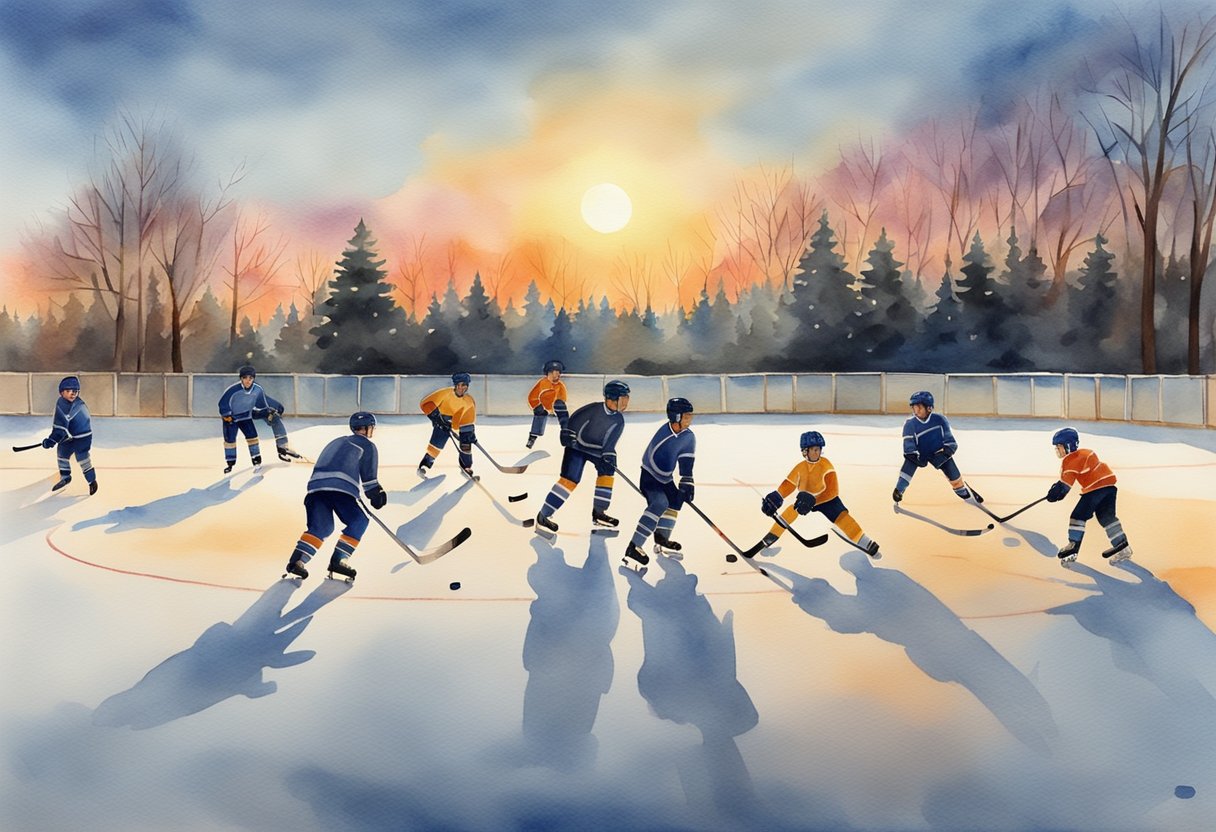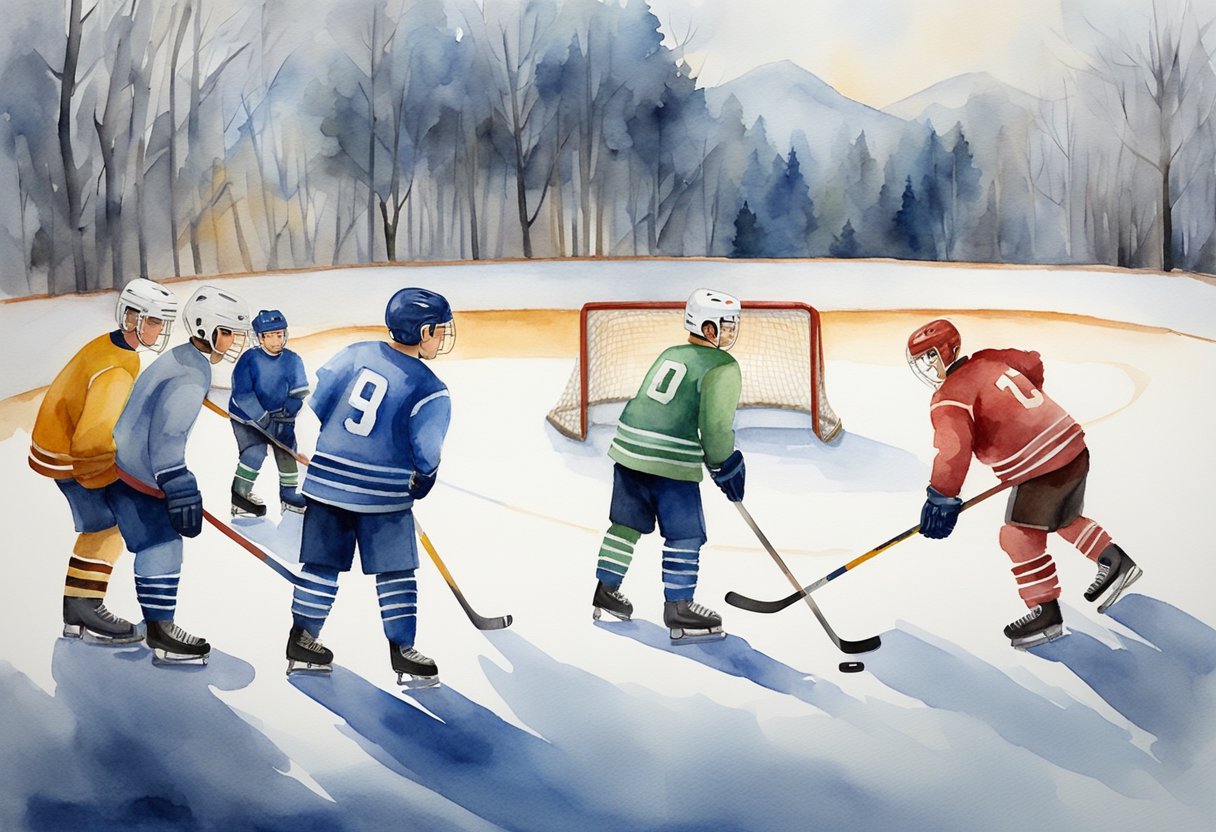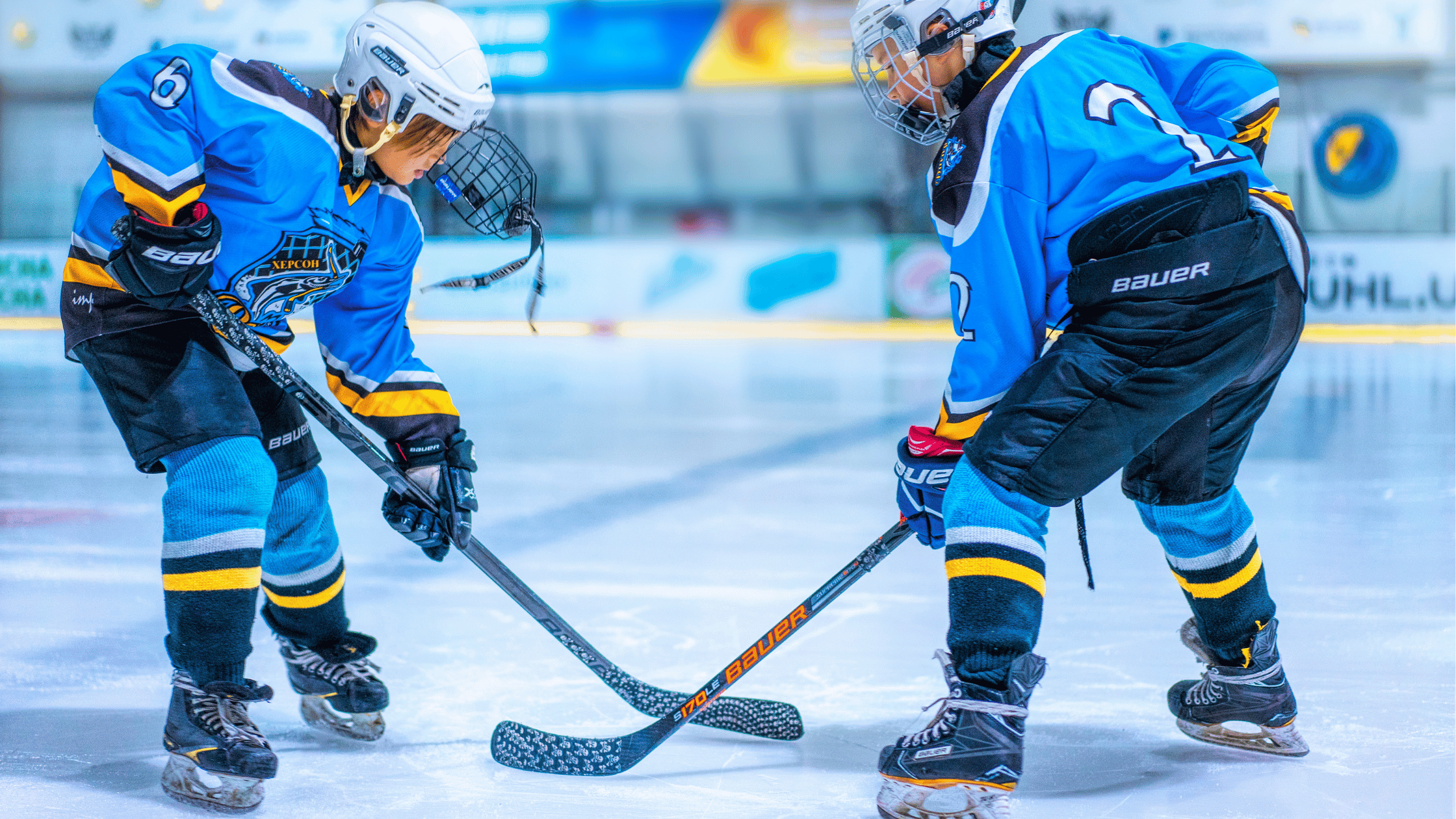Beginner’s Guide to Hockey as a Hobby: Essential Tips for Getting Started on the Ice
Hockey offers an exhilarating blend of speed, skill, and strategy that captivates players and spectators alike. If you’re looking for a new hobby that combines physical activity with teamwork and excitement, ice hockey might be the perfect fit for you.

To get started with hockey as a hobby, you’ll need basic equipment like skates, a stick, and protective gear, along with access to an ice rink and some beginner-friendly instruction. Many rinks offer learn-to-play programs designed specifically for adults new to the sport.
These classes typically cover fundamental skills like skating, puck handling, and the rules of the game.
Don’t let the fast-paced nature of hockey intimidate you. With practice and dedication, you can develop the skills needed to enjoy recreational play. The camaraderie among teammates and the thrill of improvement make hockey a rewarding hobby for beginners of all ages.
Understanding the Basics of Hockey

Hockey combines speed, skill, and strategy on an ice rink. You’ll need to grasp the playing surface, essential gear, key rules, and player roles to get started in this exciting sport.
The Hockey Rink Explained
The hockey rink is a rectangular ice surface with rounded corners. It’s divided into three main zones by blue lines: defensive, neutral, and offensive. The red center line splits the rink in half.
Face-off circles are located in each zone, where play resumes after stoppages. The goal crease is a semi-circular area in front of each net where goalies have special privileges.
Boards and plexiglass surround the rink, keeping the puck in play. Players can use these surfaces strategically to pass or clear the puck.
Equipment Essentials
To play hockey safely, you’ll need:
- Skates
- Helmet with face mask
- Shoulder pads
- Elbow pads
- Hockey gloves
- Shin guards
- Hockey stick
- Protective cup
For goalies, additional equipment includes:
- Larger leg pads
- Blocker
- Catching glove
- Chest protector
Your stick should be the right length – reaching your chin when standing on skates. Proper-fitting gear is crucial for safety and performance.
Rules Overview
The basic objective is to score more goals than your opponent. Each team fields six players at a time: three forwards, two defensemen, and one goalie.
Key rules include:
- No icing (shooting the puck from behind the center red line past the opponent’s goal line)
- Offside (entering the offensive zone before the puck)
- Body checking (legal in certain leagues, with restrictions)
Penalties result in power plays, where the penalized team plays shorthanded. Common infractions include tripping, hooking, and high-sticking.
Player Positions and Roles
Forwards:
- Center: Takes face-offs, plays both offense and defense
- Left Wing and Right Wing: Focus on scoring and forechecking
Defensemen:
- Protect their own goal
- Initiate breakouts
- Support offensive plays
Goalie:
- Defends the net
- Directs teammates
- Handles the puck behind the net
Each position requires specific skills. Centers need strong face-off abilities, wingers should have quick shots, defensemen need good passing skills, and goalies must have excellent reflexes.
Getting Started with Hockey

Hockey offers an exciting blend of skill, teamwork, and physical activity. To begin your hockey journey, you’ll need to acquire essential gear, connect with local players, and develop fundamental skills.
Choosing the Right Gear
Start with the basics: skates, a stick, and protective equipment. Look for well-fitting skates that provide ankle support. A properly sized stick should reach between your chin and nose when standing on skates.
Essential protective gear includes a helmet, shoulder pads, elbow pads, gloves, shin guards, and a cup.
For beginners, used equipment can be a cost-effective option. Visit local sports shops or online marketplaces for deals. Don’t skimp on helmet quality – it’s crucial for safety.
Remember, you don’t need top-of-the-line gear to start. Focus on comfort and protection rather than brand names.
Finding a Local Hockey Community
Search online for adult hockey leagues or beginner programs in your area. Many rinks offer “learn to play” sessions specifically for adults new to the sport.
Check community bulletin boards or social media groups for pickup games. These informal sessions are great for practice and meeting fellow hockey enthusiasts.
Consider joining a hockey fitness class to improve your conditioning. These classes often combine off-ice training with on-ice skill development.
Don’t hesitate to reach out to local rinks directly. They can provide information about upcoming events, leagues, or classes suitable for beginners.
Learning Basic Skills
Start by mastering the fundamentals of skating. Practice forward and backward skating, stopping, and turning. Balance and edge control are key to maneuvering on the ice.
Work on stick handling skills. Begin with stationary puck control, then progress to moving with the puck. Practice passing and shooting against a wall or with a partner.
Attend stick and puck sessions at your local rink to practice in a less structured environment. These sessions allow you to work on individual skills at your own pace.
Consider taking lessons from a qualified instructor. They can provide personalized feedback and help you develop proper technique from the start.
Developing Your Skills

Improving your hockey abilities requires consistent practice and focus on key areas. Mastering fundamental techniques will elevate your performance on the ice and enhance your overall enjoyment of the sport.
Practice Drills for Beginners
Start with basic stick handling drills to build coordination. Practice dribbling a ball or puck in place, then progress to moving while controlling it. Work on passing accuracy by setting up targets and aiming for them.
Try cone weaving drills to improve agility and puck control simultaneously. Set up a row of cones and navigate through them while maintaining possession.
Incorporate shooting practice into your routine. Begin with stationary shots, focusing on proper form and accuracy. Gradually add movement to simulate game scenarios.
Improving Skating Techniques
Proper skating technique forms the foundation of hockey skills. Focus on maintaining a low, balanced stance with knees bent and weight centered over your feet.
Practice stopping on both sides to increase your maneuverability. Work on quick starts and acceleration by pushing off with powerful strides.
Incorporate crossovers into your skating practice to improve your ability to change directions smoothly. Practice both forward and backward crossovers.
Dedicate time to edge work exercises. These drills enhance your balance and control on the ice, crucial for tight turns and quick direction changes.
Mastering Stick Handling
Develop your stick handling skills through repetitive practice. Start with basic forehand and backhand movements, keeping your eyes up to simulate game conditions.
Progress to more complex maneuvers like toe drags and quick shifts from forehand to backhand. Practice these moves while stationary, then add movement.
Incorporate obstacles in your drills to simulate defenders. Use cones or other objects to weave around while maintaining puck control.
Work on receiving passes on both your forehand and backhand. Practice cushioning the puck to maintain control and set up your next move quickly.
Enhancing Game Strategy
Study positioning for your preferred role, whether it’s forward, defenseman, or goalie. Understand your responsibilities in different game situations.
Learn to read the play and anticipate your opponents’ moves. Practice decision-making skills through scenario-based drills or by watching professional games.
Develop your hockey IQ by studying team formations and common plays. Familiarize yourself with offensive and defensive strategies used in the sport.
Work on your communication skills on the ice. Practice calling for passes and alerting teammates to potential threats or opportunities during scrimmages.
Safety and Injury Prevention

Hockey can be an exhilarating sport, but it’s crucial to prioritize safety to enjoy it fully. Proper equipment, warm-up routines, and injury awareness are key elements in preventing accidents and ensuring a positive experience on the ice.
Proper Use of Safety Equipment
Wearing the right protective gear is essential in hockey. Your helmet should fit snugly and have a full face mask or visor.
Shoulder pads, elbow pads, and shin guards protect your upper body and legs from impacts. Wear hockey gloves to shield your hands and wrists. A protective cup is vital for male players.
Ensure your skates fit well and provide adequate ankle support.
Inspect your equipment regularly for wear and tear. Replace any damaged items promptly. Properly fitted gear not only protects you but also enhances your performance on the ice.
Warm-Up and Cool-Down Routines
Before hitting the ice, spend 10-15 minutes warming up. Start with light cardio like jogging or jumping jacks to increase your heart rate. Follow with dynamic stretches focusing on your legs, hips, and shoulders.
On the ice, begin with slow skating drills to acclimate your body. Gradually increase intensity as you feel more comfortable.
After practice or games, cool down with 5-10 minutes of light skating. Finish with static stretches, holding each for 15-30 seconds. This helps reduce muscle soreness and improves flexibility.
Stay hydrated throughout your activities. Drink water before, during, and after playing to maintain optimal performance and recovery.
Recognizing and Treating Common Injuries
Be aware of common hockey injuries like sprains, strains, and bruises. If you experience sharp pain, swelling, or limited movement, stop playing immediately.
For minor injuries, remember RICE: Rest, Ice, Compression, and Elevation. Apply ice for 15-20 minutes every 2-3 hours to reduce swelling.
Concussions are serious. If you experience headache, dizziness, or confusion after a hit, seek medical attention right away. Never return to play until cleared by a healthcare professional.
Learn proper checking techniques to avoid causing or receiving injuries. Always play within your skill level and follow the rules to ensure a safe environment for everyone on the ice.
Joining the Hockey Community

Becoming part of the hockey community offers numerous opportunities to enhance your experience and skills. You’ll find ways to participate actively, support your favorite teams, and connect with fellow enthusiasts.
Leagues and Recreational Play
Local ice rinks and community centers often host recreational hockey leagues for adults of all skill levels. Check their websites or bulletin boards for information on beginner-friendly programs.
Many cities have organizations dedicated to adult recreational hockey, offering structured seasons and tournaments.
You can also explore pick-up games, which provide a more casual environment to practice and meet other players. Apps and websites like Hockey Community help you find nearby pick-up games and connect with other players in your area.
For those new to the sport, some leagues offer “learn to play” programs. These typically include basic skills instruction and supervised scrimmages to help you gain confidence on the ice.
Supporting Professional Teams
Attending professional hockey games is an exciting way to immerse yourself in the sport’s culture. Purchase tickets to local NHL, AHL, or junior league games.
Many teams offer special promotions or discounted tickets for first-time attendees.
Consider joining a fan club for your favorite team. These groups often organize watch parties, discussions, and sometimes even meet-and-greets with players.
Follow your chosen team on social media platforms for updates, behind-the-scenes content, and interactive fan experiences.
Many teams also have official podcasts or YouTube channels that provide in-depth coverage and analysis.
Networking with Other Hobbyists
Online forums and social media groups are excellent platforms to connect with fellow hockey enthusiasts. Join Reddit communities like r/hockeyplayers to share experiences, ask questions, and get advice from more experienced players.
Participate in local hockey events such as charity games, skills clinics, or equipment swaps. These gatherings offer opportunities to meet like-minded individuals and expand your hockey network.
Consider volunteering at youth hockey programs or local tournaments. This allows you to give back to the community while building connections with other adults involved in the sport.
Attending Games and Events

Attending hockey games and events is an exciting way to immerse yourself in the sport. You’ll experience the electric atmosphere, connect with other fans, and see the game up close. Proper preparation ensures you make the most of these outings.
How to Choose Events to Attend
Start with local games to get a feel for live hockey. Look for minor league or junior hockey matches in your area. These are often more affordable and accessible than NHL games.
Check team schedules and plan ahead for big rivalry games or special events. The NHL Winter Classic, held outdoors on New Year’s Day, offers a unique experience.
Consider your budget and availability when selecting games. Weeknight games are typically cheaper than weekend matches. Early-season games may have better ticket availability and lower prices.
Sign up for team newsletters or follow social media accounts for ticket deals and promotions. Some teams offer discounted packages for multiple games or group rates.
Understanding Fan Etiquette
Arrive early to find your seat and settle in before the action starts. This allows time to explore the arena and avoid disrupting others during play.
Stand for the national anthem(s) and remove your hat as a sign of respect. During play, remain seated unless cheering or visiting concessions to avoid blocking other fans’ views.
Cheer enthusiastically for your team, but avoid using offensive language or heckling players excessively. Remember, there may be children present.
Be mindful of those around you. Don’t lean forward or stand up suddenly, blocking others’ views. Keep conversations at a reasonable volume during play.
Clean up after yourself and dispose of trash properly. This helps maintain a pleasant environment for all fans and arena staff.
Collecting Memorabilia
Start your collection with affordable items like team posters, pucks, or programs from games you attend. These serve as great mementos of your experiences.
Look for player autograph sessions at the arena or local events. Bring items to be signed or purchase official merchandise for autographs.
Consider investing in authentic jerseys of your favorite players. Wear them to games or display them at home as part of your collection.
Keep tickets and other paper items in protective sleeves to preserve them. Store pucks and other objects in display cases to prevent damage.
Join online forums or local collector groups to learn about rare items and fair prices. This can help you avoid overpaying and find unique pieces for your collection.
Training and Fitness for Hockey

Developing physical fitness and mental readiness is crucial for hockey players at all levels. A well-rounded approach includes off-ice conditioning, proper nutrition, and mental preparation techniques.
Off-Ice Conditioning
Focus on exercises that improve strength, speed, and endurance. Incorporate weightlifting to build muscle and power. Squats, deadlifts, and lunges target key leg muscles used in skating.
Add plyometric exercises like box jumps and lateral hops to enhance explosiveness. These movements mimic the quick bursts needed on the ice.
Cardiovascular training is essential. Mix in high-intensity interval training (HIIT) with longer, steady-state cardio sessions. This combination builds both anaerobic and aerobic capacity.
Include core work to improve stability and balance. Planks, Russian twists, and medicine ball rotations strengthen your midsection, aiding in stick handling and shooting.
Nutritional Guidance for Hockey Players
Fuel your body properly to support intense training and gameplay. Aim for a balanced diet rich in complex carbohydrates, lean proteins, and healthy fats.
Carbohydrates provide energy for practices and games. Choose whole grains, fruits, and vegetables. Consume protein to aid muscle recovery and growth. Lean meats, fish, and plant-based options are excellent sources.
Stay hydrated by drinking water throughout the day. During intense activity, consider sports drinks to replenish electrolytes.
Time your meals strategically. Eat a substantial meal 3-4 hours before playing, followed by a lighter snack 30-60 minutes prior to hitting the ice.
Mental Preparation Techniques
Develop a pre-game routine to get into the right mindset. This might include visualization exercises, where you imagine successful plays and positive outcomes.
Practice deep breathing techniques to manage stress and anxiety. Slow, controlled breaths can help calm nerves before and during games.
Set realistic goals for each practice and game. Focus on specific skills you want to improve, rather than just winning or losing.
Use positive self-talk to boost confidence. Replace negative thoughts with encouraging statements about your abilities and preparation.
Learn to stay focused in high-pressure situations. Develop a mantra or key phrase to refocus your attention when distractions arise.
Family and Youth Involvement

Hockey offers excellent opportunities for family bonding and youth development. Getting involved as a family can create lasting memories and instill a love for the sport in children from an early age.
Introducing Children to Hockey
Start by taking your kids to watch local hockey games. This exposes them to the excitement and atmosphere of the sport. At home, show them hockey highlights or documentaries to spark their interest.
Consider enrolling your child in learn-to-skate programs. These classes teach basic skating skills essential for hockey. Many rinks offer introductory hockey clinics for young beginners.
Provide age-appropriate equipment for safety. Start with skates, a helmet, gloves, and a stick. Add more gear as your child progresses.
Encourage backyard or driveway practice. Set up a small net and let your kids shoot pucks or balls. This helps develop basic stick-handling skills.
Family-Friendly Hockey Activities
Organize family skating outings at local rinks. This builds confidence on the ice and creates fun memories.
Set up a mini-rink in your backyard during winter. Use a tarp or plastic sheeting to create an ice surface for family games.
Attend hockey-themed events together. Look for opportunities like open skates with local teams or hockey festivals.
Play street hockey as a family. This low-pressure activity helps everyone learn basic rules and techniques.
Watch professional games together. Discuss strategies and player positions to enhance understanding of the sport.
Volunteer at youth hockey events. This exposes your family to the hockey community and teaches valuable lessons about teamwork and sportsmanship.
Advancing Your Hockey Hobby

As you progress in hockey, opportunities for skill development and competitive play expand. Structured training and amateur tournaments offer paths to enhance your abilities and experience the thrill of competition.
Attending Hockey Clinics and Camps
Hockey clinics and camps provide intensive training to sharpen your skills. These programs often focus on specific aspects like skating, stickhandling, or positional play. Many are led by experienced coaches or former professional players.
Look for clinics that match your skill level and goals. Some may span a weekend, while others run for several weeks. You’ll benefit from professional instruction, drills, and scrimmages.
Camps often include off-ice training to improve strength and agility. They can also teach you about nutrition and mental preparation. These experiences help you build connections with other players and coaches.
Exploring Amateur Tournaments
Amateur tournaments offer exciting opportunities to test your skills in a competitive setting. You can join a team or form one with friends to participate in local or regional events.
Tournaments come in various formats, from one-day jamborees to weekend-long competitions. They often group teams by age and skill level to ensure fair matchups.
Participating in tournaments improves your game sense and ability to perform under pressure. You’ll learn to adapt to different playing styles and strategies. These events also foster team bonding and create lasting memories.
Research tournaments in your area and prepare your team well in advance. Ensure you have the necessary equipment and are familiar with tournament rules and schedules.
Staying Updated with Hockey

Staying informed about hockey developments enhances your enjoyment and knowledge of the sport. You can leverage various resources to keep up with the latest news, games, and trends.
Following Hockey News and Updates
Subscribe to reputable hockey news websites and mobile apps for real-time updates. NHL.com and TSN.ca offer comprehensive coverage of professional hockey leagues. Follow your favorite teams and players on social media platforms like Twitter and Instagram for behind-the-scenes content and personal insights.
Join online hockey forums and discussion boards to engage with other fans. These communities often share breaking news and analyze games in-depth.
Consider subscribing to hockey-focused podcasts for expert commentary and analysis. Many former players and coaches host shows, providing unique perspectives on the sport.
Using Technology to Enhance Your Hobby
Download hockey stats apps to track player performance and team standings. These tools can help you make informed decisions for fantasy leagues or simply deepen your understanding of the game.
Utilize streaming services to watch live games and highlights. NHL.TV and ESPN+ offer extensive hockey coverage, allowing you to follow multiple teams and leagues.
Explore virtual reality (VR) hockey experiences for immersive training simulations. VR technology can help you visualize plays and improve your understanding of on-ice positioning.
Try hockey-themed video games to enjoy the sport from a different angle. Games like NHL 24 offer realistic gameplay and can help you learn more about team strategies and player roles.
Frequently Asked Questions

New hockey players often have many questions as they get started in the sport.
From equipment needs to skill development and understanding game rules, there’s a lot to learn when beginning your hockey journey.
What gear is needed for someone starting out in hockey?
Essential gear for beginners includes skates, a helmet, gloves, shin guards, and a stick.
You’ll also need shoulder pads, elbow pads, hockey pants, and a protective cup. A jersey and socks complete the basic outfit.
For goalies, additional equipment like a mask, chest protector, and leg pads are necessary.
Renting or borrowing gear can be a cost-effective option when first starting out.
How can beginners improve their hockey skills?
Practice skating regularly to build a strong foundation. Focus on balance, stopping, and changing directions.
Work on stick handling skills off the ice to improve coordination.
Attend hockey clinics or join a beginner’s league to learn from experienced players and coaches.
Watch professional games to observe techniques and strategies.
Consider taking private lessons to address specific areas for improvement.
Regular off-ice exercises can enhance your strength and endurance for better on-ice performance.
What are some basic strategies for understanding the game of hockey?
Learn the positions and their roles on the ice. Familiarize yourself with common plays like the forecheck, backcheck, and power play.
Understand the importance of teamwork and passing.
Study offensive and defensive zone strategies. Learn how to read the play and anticipate your opponents’ moves.
Practice situational awareness to improve your decision-making on the ice.
How are penalties and infractions handled in hockey?
Minor penalties result in two minutes in the penalty box. Major penalties carry a five-minute penalty. Game misconduct penalties lead to ejection from the game.
Common infractions include slashing, tripping, and high-sticking.
The offending team plays shorthanded during the penalty, creating a power play opportunity for the opposing team.
Penalties can be offset if both teams commit infractions simultaneously.
Some serious infractions may result in suspensions or fines, especially at higher levels of play.
Where is the best place for a beginner to practice and play hockey?
Local ice rinks often offer public skating sessions and beginner hockey classes. Look for adult learn-to-play programs or recreational leagues in your area.
Outdoor rinks can be great for casual practice during winter months. Some communities have roller hockey facilities for year-round play.
Consider joining a hockey clinic or attending a hockey camp to receive structured instruction and practice time.
Many rinks also offer stick and puck sessions for individual skill development.
Can adults who have never skated before still learn to play hockey?
Yes, adults can absolutely learn to play hockey, even without prior skating experience.
Many rinks offer adult beginner classes specifically designed for new skaters.
Start with basic skating lessons to build confidence on the ice.
Progress to hockey-specific skills once you’re comfortable with skating.
Join a beginner’s league to practice in a supportive environment.
Be patient with yourself and consistent in your practice.
With dedication and regular ice time, you can develop the skills needed to enjoy playing hockey at any age.

